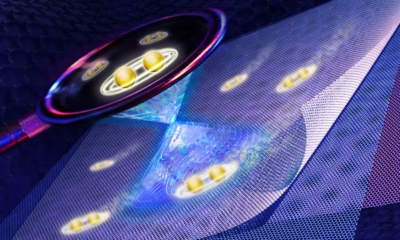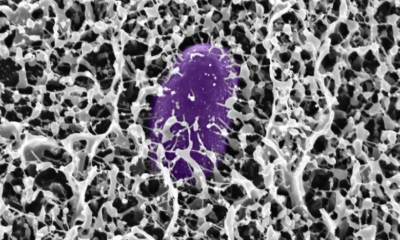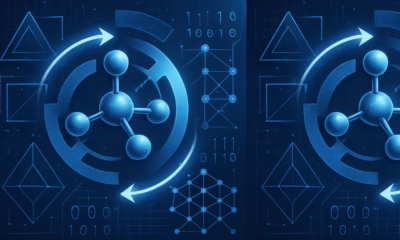Space & Physics
MIT Physicists uncover key Mechanism behind fractional charge in Graphene
In the decades-long history of studying these phenomena, no one has observed a system that naturally leads to such fractional electron effects, according to the researchers.

MIT physicists have made a significant breakthrough in understanding the phenomenon where electrons split into fractions of their usual charge, offering new insights into the behaviour of exotic electronic states in graphene and other two-dimensional materials.
This latest research builds on a discovery earlier this year, when a team led by Assistant Professor Long Ju at MIT reported that electrons in pentalayer graphene—a structure composed of five graphene layers stacked on top of boron nitride—exhibited fractional charge. Remarkably, this behaviour was observed without the application of a magnetic field, challenging prior assumptions.
Previously, scientists knew that under a strong magnetic field, electrons could split into fractions as part of the fractional quantum Hall effect. However, Ju’s findings marked the first time such fractional behaviour occurred in graphene without any magnetic influence, which led to the coining of the “fractional quantum anomalous Hall effect.” Since then, researchers have been eager to uncover how fractional charge could emerge in this unusual system.
MIT professor Senthil Todadri, who led the new study published in Physical Review Letters, offers a critical piece of the puzzle. Through detailed quantum mechanical calculations, Todadri and his team discovered that the electrons in pentalayer graphene form a crystal-like structure, which provides the ideal conditions for fractional electron behavior.
“This is a completely new mechanism,” said Todadri. “In the decades-long history of studying these phenomena, no one has observed a system that naturally leads to such fractional electron effects. It opens the door to all kinds of new experimental possibilities.”
The study, which includes contributions from Zhihuan Dong and former postdoc Adarsh Patri, is part of a wider body of research. Two other teams—one from Johns Hopkins University and another from Harvard University, UC Berkeley, and Lawrence Berkeley National Laboratory—have also reported similar findings in the same journal issue.
Building on “Twistronics” and the Magic-Angle Graphene Discovery
This research builds upon the work of MIT physicist Pablo Jarillo-Herrero and his team, who in 2018 were the first to demonstrate that twisting two sheets of graphene could give rise to novel electronic behaviors. This discovery of “magic-angle graphene” spurred a new field known as “twistronics,” focused on understanding how the interactions between twisted two-dimensional materials could lead to unusual quantum phenomena, such as superconductivity and insulating behavior.
“We quickly realized that these twisted systems could provide the right conditions for fractional electron phenomena to emerge,” said Todadri, who collaborated with Jarillo-Herrero on a 2018 study that theorized such systems might exhibit fractional charge without a magnetic field. “We saw these systems as ideal platforms to study these fractional effects.”
A Surprising Discovery and the New Crystal Model
In September 2023, Todadri received an unexpected call from Ju, who was eager to share data showing fractional charge behavior in pentalayer graphene. This discovery caught Todadri by surprise, as it did not align with his earlier predictions. In his 2018 paper, Todadri had theorized that fractional charge would emerge from a specific twisting of the electron wavefunction, and that this twisting would intensify as more graphene layers were added.
“Initially, we expected the wavefunction to wind five times in pentalayer graphene,” Todadri explained. “But Ju’s experiments showed that it only wound once. This raised a big question—how do we explain what we’re seeing?”
Uncovering the Electron “Crystal”
Todadri and his team revisited their hypothesis and discovered they had overlooked an important factor. The conventional approach in the field had been to treat electrons as independent entities and analyze their quantum properties. However, in the confined, two-dimensional space of pentalayer graphene, electrons are forced to interact with each other, behaving according to their quantum correlations in addition to their natural repulsion.
By incorporating these interelectron interactions into their model, the team was able to match their predictions with the experimental data Ju had obtained. This led them to a crucial realization: the moiré pattern formed by the stacked graphene layers induces a weak electrical potential that forces the electrons to interact and form a crystal-like structure. This electron “crystal” creates a complex pattern of quantum correlations, allowing for the formation of fractional charge.
“The crystal has a whole set of unique properties that differentiate it from ordinary crystals,” said Todadri. “This opens up many exciting avenues for future research. In the short term, our work provides a theoretical foundation for understanding the fractional electron observations in pentalayer graphene and predicting similar phenomena in other systems.”
This new insight paves the way for further exploration into how graphene and other two-dimensional materials might be used to engineer new electronic states, with potential applications in quantum computing and other advanced technologies.
Space & Physics
MIT Pioneers Real-Time Observation of Unconventional Superconductivity in Magic-Angle Graphene
Physicists have directly observed unconventional superconductivity in magic-angle twisted tri-layer graphene using a new experimental platform, revealing a unique pairing mechanism
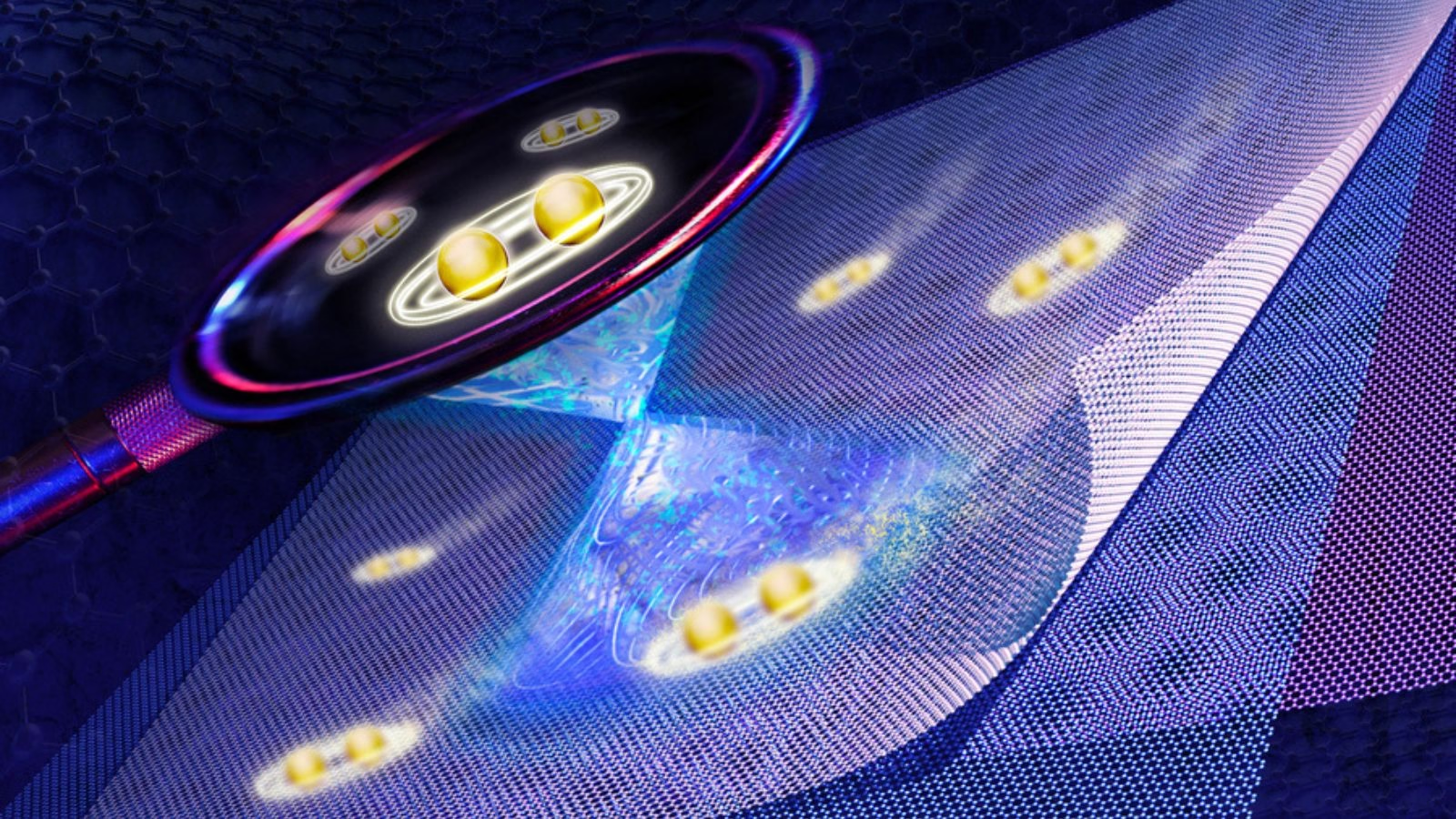
MIT physicists have unveiled compelling direct evidence for unconventional superconductivity in “magic-angle” twisted tri-layer graphene—an atomically engineered material that could reimagine the future of energy transport and quantum technologies. Their new experiment marks a pivotal step forward, offering a fresh perspective on how electrons synchronize in precisely stacked two-dimensional materials, potentially laying the groundwork for next-generation superconductors that function well above current temperature limits.
Instead of looking merely at theoretical possibilities, the MIT team built a novel platform that lets researchers visualize the superconducting gap “as it emerges in real-time within 2D materials,” said co-lead author Shuwen Sun in a media statement. This gap is crucial, reflecting how robust the material’s superconducting state is during temperature changes—a key indicator for practical applications.
What’s striking, said Jeong Min Park, study co-lead author, is that the superconducting gap in magic-angle graphene differs starkly from the smooth, uniform profile seen in conventional superconductors. “We observed a V-shaped gap that reveals an entirely new pairing mechanism—possibly driven by the electrons themselves, rather than crystal vibrations,” Park said. Such direct measurement is a “first” for the field, giving scientists a more refined tool for identifying and understanding unconventional superconductivity.
Senior author Pablo Jarillo-Herrero emphasized that their method could help crack the code behind room-temperature superconductors: “This breakthrough may trigger deeper insights not just for graphene, but for the entire class of twistronic materials. Imagine grids and quantum computers that operate with zero energy loss—this is the holy grail we’re moving toward,” Jarillo-Herrero said in the MIT release.
Collaborators included scientists from Japan’s National Institute for Materials Science, broadening the impact of the research. The discovery builds on years of progress since the first magic-angle graphene experiments in 2018, opening what many now call the “twistronics” era—a field driven by stacking and twisting atom-thin materials to unlock uniquely quantum properties.
Looking ahead, the team plans to expand its analysis to other ultra-thin structures, hoping to map out electronic behavior not only for superconductors, but for a wider range of correlated quantum phases. “We can now directly observe electron pairs compete and coexist with other quantum states—this could allow us to design new materials from the ground up,” said Park in her public statement.
The research underscores the value of visualization in fundamental physics, suggesting that direct observation may be the missing link to controlling quantum phenomena for efficient, room-temperature technology.
Space & Physics
Atoms Speak Out: Physicists Use Electrons as Messengers to Unlock Secrets of the Nucleus
Physicists at MIT have devised a table-top method to peer inside an atom’s nucleus using the atom’s own electrons
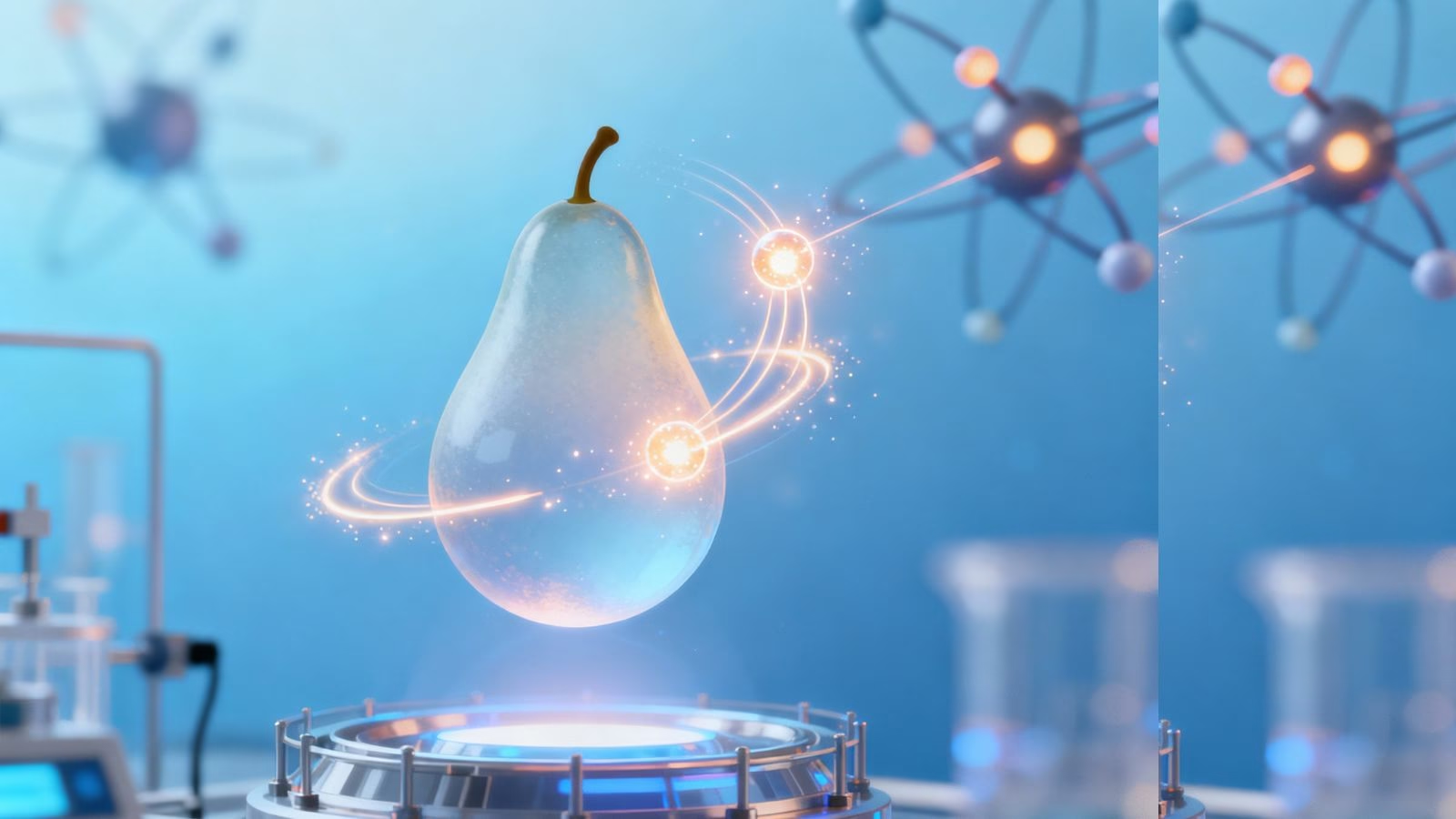
Physicists at MIT have developed a pioneering method to look inside an atom’s nucleus — using the atom’s own electrons as tiny messengers within molecules rather than massive particle accelerators.
In a study published in science, the researchers demonstrated this approach using molecules of radium monofluoride, which pair a radioactive radium atom with a fluoride atom. The molecules act like miniature laboratories where electrons naturally experience extremely strong electric fields. Under these conditions, some electrons briefly penetrate the radium nucleus, interacting directly with protons and neutrons inside. This rare intrusion leaves behind a measurable energy shift, allowing scientists to infer details about the nucleus’ internal structure.
The team observed that these energy shifts, though minute — about one millionth of the energy of a laser photon — provide unambiguous evidence of interactions occurring inside the nucleus rather than outside it. “We now have proof that we can sample inside the nucleus,” said Ronald Fernando Garcia Ruiz, the Thomas A. Franck Associate Professor of Physics at MIT, in a statement. “It’s like being able to measure a battery’s electric field. People can measure its field outside, but to measure inside the battery is far more challenging. And that’s what we can do now.”
Traditionally, exploring nuclear interiors required kilometer-long particle accelerators to smash high-speed beams of electrons into targets. The MIT technique, by contrast, achieves similar insight with a table-top molecular setup. It makes use of the molecule’s natural electric environment to magnify these subtle interactions.
The radium nucleus, unlike most which are spherical, has an asymmetric “pear” shape that makes it a powerful system for studying violations of fundamental physical symmetries — phenomena that could help explain why the universe contains far more matter than antimatter. “The radium nucleus is predicted to be an amplifier of this symmetry breaking, because its nucleus is asymmetric in charge and mass, which is quite unusual,” Garcia Ruiz explained.
To conduct their experiments, the researchers produced radium monofluoride molecules at CERN’s Collinear Resonance Ionization Spectroscopy (CRIS) facility, trapped and cooled them in laser-guided chambers, and then measured laser-induced energy transitions with extreme precision. The work involved MIT physicists Shane Wilkins, Silviu-Marian Udrescu, and Alex Brinson, alongside international collaborators.
“Radium is naturally radioactive, with a short lifetime, and we can currently only produce radium monofluoride molecules in tiny quantities,” said Wilkins. “We therefore need incredibly sensitive techniques to be able to measure them.”
As Udrescu added, “When you put this radioactive atom inside of a molecule, the internal electric field that its electrons experience is orders of magnitude larger compared to the fields we can produce and apply in a lab. In a way, the molecule acts like a giant particle collider and gives us a better chance to probe the radium’s nucleus.”
Going forward, the MIT team aims to cool and align these molecules so that the orientation of their pear-shaped nuclei can be controlled for even more detailed mapping. “Radium-containing molecules are predicted to be exceptionally sensitive systems in which to search for violations of the fundamental symmetries of nature,” Garcia Ruiz said. “We now have a way to carry out that search”
Space & Physics
Physicists Double Precision of Optical Atomic Clocks with New Laser Technique
MIT researchers develop a quantum-enhanced method that doubles the precision and stability of optical atomic clocks, paving the way for portable, ultra-accurate timekeeping.
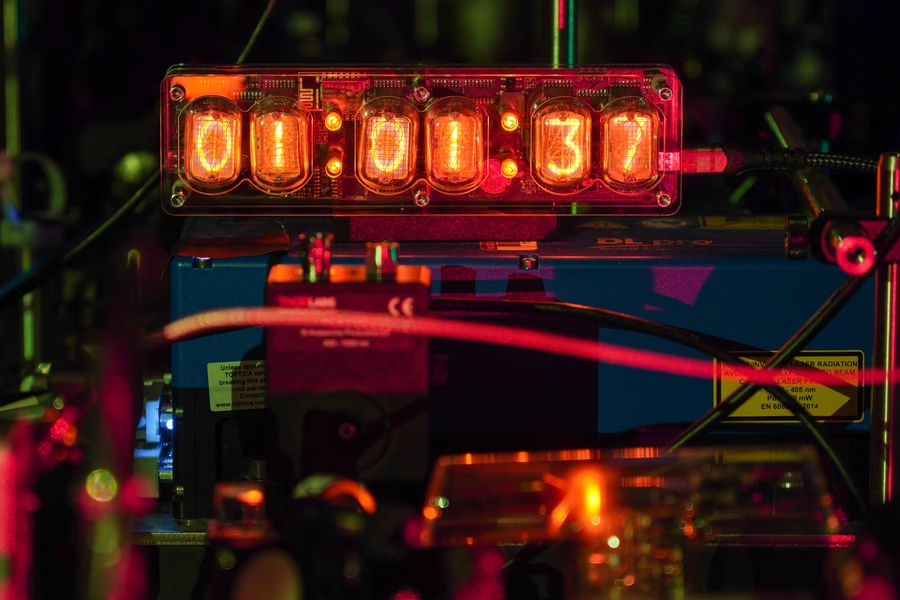
MIT physicists have unveiled a new technique that could significantly improve the precision and stability of next-generation optical atomic clocks, devices that underpin everything from mobile transactions to navigation apps. In a recent media statement, the MIT team explained: “Every time you check the time on your phone, make an online transaction, or use a navigation app, you are depending on the precision of atomic clocks. An atomic clock keeps time by relying on the ‘ticks’ of atoms as they naturally oscillate at rock-steady frequencies.”
Current atomic clocks rely on cesium atoms tracked with lasers at microwave frequencies, but scientists are advancing to clocks based on faster-ticking atoms like ytterbium, which can be tracked with lasers at higher, optical frequencies and discern intervals up to 100 trillion times per second.
A research group at MIT, led by Vladan Vuletić, the Lester Wolfe Professor of Physics, detailed that their newly developed method harnesses a laser-induced “global phase” in ytterbium atoms and boosts this effect using quantum amplification. Vuletić stated, “We think our method can help make these clocks transportable and deployable to where they’re needed.” The approach, called global phase spectroscopy, doubles the precision of an optical atomic clock, enabling it to resolve twice as many ticks per second compared to standard setups, and promises further gains with increasing atom counts.
The technique could pave the way for portable optical atomic clocks able to measure all manner of phenomena in various locations. Vuletić summarized the broader scientific ambitions: “With these clocks, people are trying to detect dark matter and dark energy, and test whether there really are just four fundamental forces, and even to see if these clocks can predict earthquakes.”
The MIT team has previously demonstrated improved clock precision by quantumly entangling hundreds of ytterbium atoms and using time reversal tricks to amplify their signals. Their latest advance applies these methods to much faster optical frequencies, where stabilizing the clock laser has always been a major challenge. “When you have atoms that tick 100 trillion times per second, that’s 10,000 times faster than the frequency of microwaves,” said Vuletić in the statement. Their experiments revealed a surprisingly useful “global phase” information about the laser frequency, previously thought irrelevant, unlocking the potential for even greater accuracy.
The research, led by Vuletić and joined by Leon Zaporski, Qi Liu, Gustavo Velez, Matthew Radzihovsky, Zeyang Li, Simone Colombo, and Edwin Pedrozo-Peñafiel of the MIT-Harvard Center for Ultracold Atoms, was published in Nature. They believe the technical benefits of the new method will make atomic clocks easier to run and enable stable, transportable clocks fit for future scientific exploration, including earthquake prediction, fundamental physics, and global time standards.
-

 Space & Physics6 months ago
Space & Physics6 months agoIs Time Travel Possible? Exploring the Science Behind the Concept
-

 Know The Scientist6 months ago
Know The Scientist6 months agoNarlikar – the rare Indian scientist who penned short stories
-

 Know The Scientist5 months ago
Know The Scientist5 months agoRemembering S.N. Bose, the underrated maestro in quantum physics
-

 Space & Physics3 months ago
Space & Physics3 months agoJoint NASA-ISRO radar satellite is the most powerful built to date
-

 Society5 months ago
Society5 months agoAxiom-4 will see an Indian astronaut depart for outer space after 41 years
-

 Society5 months ago
Society5 months agoShukla is now India’s first astronaut in decades to visit outer space
-

 Society5 months ago
Society5 months agoWhy the Arts Matter As Much As Science or Math
-

 Earth5 months ago
Earth5 months agoWorld Environment Day 2025: “Beating plastic pollution”

